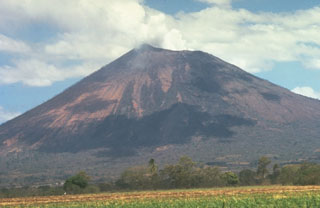Report on San Cristobal (Nicaragua) — 2 September-8 September 2009
Smithsonian Institution / US Geological Survey
Weekly Volcanic Activity Report, 2 September-8 September 2009
Managing Editor: Sally Sennert.
Please cite this report as:
Global Volcanism Program, 2009. Report on San Cristobal (Nicaragua) (Sennert, S, ed.). Weekly Volcanic Activity Report, 2 September-8 September 2009. Smithsonian Institution and US Geological Survey.
San Cristobal
Nicaragua
12.702°N, 87.004°W; summit elev. 1745 m
All times are local (unless otherwise noted)
Based on analysis of satellite imagery and information from the Tegucigalpa MWO, the Washington VAAC reported that on 6 September an explosion from San Cristóbal produced an ash plume that rose to an altitude no higher than 8.5 km (28,000 ft) a.s.l. The plume drifted 75 km W. According to a news article, ashfall was reported in nearby towns.
Geological Summary. The San Cristóbal volcanic complex, consisting of five principal volcanic edifices, forms the NW end of the Marrabios Range. The symmetrical 1745-m-high youngest cone, named San Cristóbal (also known as El Viejo), is Nicaragua's highest volcano and is capped by a 500 x 600 m wide crater. El Chonco, with several flank lava domes, is located 4 km W of San Cristóbal; it and the eroded Moyotepe volcano, 4 km NE of San Cristóbal, are of Pleistocene age. Volcán Casita, containing an elongated summit crater, lies immediately east of San Cristóbal and was the site of a catastrophic landslide and lahar in 1998. The Plio-Pleistocene La Pelona caldera is located at the eastern end of the complex. Historical eruptions from San Cristóbal, consisting of small-to-moderate explosive activity, have been reported since the 16th century. Some other 16th-century eruptions attributed to Casita volcano are uncertain and may have been from other Marrabios Range volcanoes.
Sources: Associated Press, Washington Volcanic Ash Advisory Center (VAAC)

